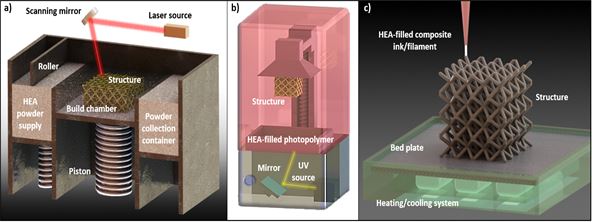
Figure 1. Schematic illustration of the set-up based on common metal 3D-printing techniques that can be used to fabricate architected HEA structures. a) Selective Laser Melting (SLM), b) Sterelithography (SLA), and c) Fused Deposition Modeling (FDM).
Figure 2. Examples of 3D-printed metal/alloy architected structures.
Opportunity
High Entropy Alloys (HEAs) can unlock extreme combinations of mechanical and functional properties owing to their distinct microstructures and vast compositional range. However, explorations primarily involve varying the composition or post-processing of monolithic bulk samples, which limits their mechanical responses and physical properties (e.g., density). This invention offers a novel strategy of fabricating architected HEAs via additive manufacturing (3D printing), allowing for direct usability, where the manufacture of intricate, ready-to-use 3D parts can be achieved with little to no post-processing. By exploiting the unique microstructures imparted by 3D printing and lightweight structural design principles of cellular architecture, 3D architected HEAs can breach the canonical coupling in material properties (e.g., strength-density, strength-ductility trade-off) while enabling unprecedented control over their geometries, mechanical behaviors, and physical properties that would otherwise be unachievable with bulk materials. This method could be further integrated with the emerging field of materials informatics to drastically reduce the time to manufacture high-performance functional parts for specific industrial applications.
Technology
The architecture is introduced by using additive manufacturing (3D printing) techniques such as Selective Laser Melting (SLM), Electron Beam Melting (EBM), Direct Metal Laser Sintering (DMLS), Two-Photon Lithography (TPL), Stereolithography (SLA), Fused Deposition Modeling (FDM), etc. Initially a CAD model of the architecture structure is designed, and then analyzed by a commercially available Finite Element software to optimize its topology/geometry to suit the desired requirements such as high specific strength etc. The optimized model is then converted into a Standard Tessellation Language (STL) file to be processed by a standard or specific slicing software. Then 2-D layers are generated. A 3D printer will print the 2D layers layer-by-layer to eventually fabricate the 3D structure. Various 3D printing technologies can be employed and/or modified to do the final printing of the structure. Upon the complete fabrication of the 3D-printed structure, post-processing techniques would be performed. This includes but not limited to thermal annealing, inserting it into a debinder oven to initially remove the supporting polymer followed by sintering in inert or forming gas environment, which results in a fully dense 3D HEA architectures.
Advantages
- By introducing architecture into the synthesis of HEAs, parts with structural hierarchies or functional gradient, exhibiting unprecedented and desirable mechanical (e.g., stronger, lighter, tougher) and functional (e.g., corrosion resistant, biocompatible, catalytic, thermoelectric, superconducting) properties can be produced in a shorter period of time.
- The method further reduces the overall cost of raw materials and time required for testing different HEAs while being able to produce lightweight, complex, 3D homogenous parts that fully utilize the numerous advantages of HEAs.
- Reduces waste material incurred as compared to traditional processing techniques where casting and machining is often needed to shape the parts into the desired shape. 3D printing can directly be used to manufacture the final parts with even greater flexibility in terms of the geometries that can be achieved.
Applications
- Prototyping and testing of new high performance, specialized HEA material to be used in industries like aerospace and construction.
- Housing for electric vehicle (EV) batteries owing to their high impact resistance and heat dissipation capabilities under high temperatures.
- Satellite housing due to their low density (lightweight) and high toughness at extreme environments (e.g., cryogenic temperature).




